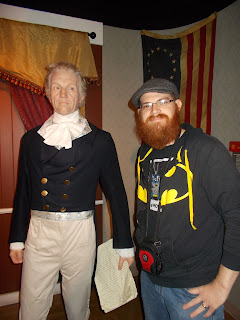 This post is talk about some odds and ends, I want to
thank everyone who has read my blog and continues to read it, to explain a
comment I got and to shamelessly plug some other projects that I am working
on. First off "The Weaving
Chronicle" has just reached over 2000 views! This may not seem like much,
but it is a pretty big milestone for me as a young historian and writer. So
thank you to all of you read and support my blog. An equally big milestone, is
that I had my first comment that challenged a statement I made in a post! I
have had comments posted by friends who offered encouragement (very grateful
for those too)! When I saw that I had a comment, I had to check it right
away! And when I read it, my heart sank
a little bit but then I reminded myself that criticism was better than silence
and the author was not rude or abusive. So I thanked the commenter and
did a mental fist pump at actually having interest in my blog posts. Here
is the comment in full.
This post is talk about some odds and ends, I want to
thank everyone who has read my blog and continues to read it, to explain a
comment I got and to shamelessly plug some other projects that I am working
on. First off "The Weaving
Chronicle" has just reached over 2000 views! This may not seem like much,
but it is a pretty big milestone for me as a young historian and writer. So
thank you to all of you read and support my blog. An equally big milestone, is
that I had my first comment that challenged a statement I made in a post! I
have had comments posted by friends who offered encouragement (very grateful
for those too)! When I saw that I had a comment, I had to check it right
away! And when I read it, my heart sank
a little bit but then I reminded myself that criticism was better than silence
and the author was not rude or abusive. So I thanked the commenter and
did a mental fist pump at actually having interest in my blog posts. Here
is the comment in full.
I have to say that, bearing in mind the examples that you
gave, implying that "walls actually have a poor success rate
throughout history" is not entirely substantiated. Walls are physical
barriers intended to keep people (and other critters) out or in. The Great Wall
of China did eventually fail, but it also held back scores of other previous
invaders. The Maginot Line failed as a wall because it was not complete; the
lack of end points and gaps made it more of nuisance than an actual physical
barrier. The other examples (the Berlin Wall and the Korean Border) worked
splendidly for their intended primary and secondary purposes: secondary to keep
people out, primary to keep people IN. If their intent was solely political in
nature, I would agree that they failed in compelling sympathy toward their
respective causes, but as physical barriers they were quite effective.
The author makes some good points.
Criticisms and rebuttals are important to the
study of history, as a professor once said “History is a conversation.” History
is not hear say, repeating whatever you have been told. It is a back and forth,
trying to understand the past better. Here
are my reasons for maintaining my opinion:
The Great Wall of China did stand for many years
before the Mongols conquered China and established the Yuan Dynasty but the
point is the wall did fail.
The Maginot Line did not fail because it was
unfinished, it failed because it was an outdated stratagem against a superior
form of warfare.
The Berlin Wall did its job very well however there
are stories of people still getting passed that obstacle (see the link http://www.huffingtonpost.com/2014/11/07/berlin-wall-escape-stories_n_6090602.html).
That being said the reason it was so successful is the same reason why the 38th
parallel is so successful because of men, mines (there were no mines in Berlin
that I know of) and machine-guns. I for one would not want to see such a
structure raised in Texas. My point is that walls have failed over the
years and will continue to fail. Those that have done their job well, is not
because the wall was too high or thick but because of the threat of force
against those who try to cross it. From ancient China around the globe and to
modern Korea. A wall will not protect the United States nor make it great.
I am very grateful to "unknown" for the
comment and please continue to comment, let me know where I missed it, nailed
it or if you have an idea for me to write about let me know.
Here is the shameless plug. If you like what you
see here, like me on face book https://www.facebook.com/Historianforeva/?view_public_for=299851710031447
and follow me on twitter https://twitter.com/Historianforeva
I and some friends of mine are working on a project
called Popstorian! It talks about the history of film, music, comic books and
all things pop-culture-ish. You can like the Facebook page here https://www.facebook.com/PopStorian/?view_public_for=1423293254642909
and follow our twitter here, https://twitter.com/PopStorian!













